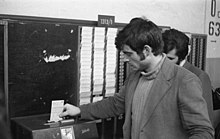Time clock

A time clock , also a control clock or time clock , is a working time meter that records the start and end of work for employees .
description
A time clock prints the employee's transit time with date and personnel number on a strip of paper inside the time clock. To do this, the employee sets the pointer of the time clock to his personnel number when he comes and goes. A lever mechanism triggers the time stamping on the paper strip inside the time clock with a "stab" of the pin located under the end of the pointer in the hole belonging to the personnel number.
A time clock automatically prints the time on a card made of cardboard. The printer moves in such a way that a different line of the card is printed on each day of the month. Working hours begin with the stamping when you come and end with the stamping when you leave. The time clock is usually located in the entrance area of the workplace. It is used equally in industry and in the service sector.
In order not to let the stamp card get too long, it usually has the lines for the 1st to 15th day on the front and the rest of the text on the back. Failure to turn the card over on the 16th of the month is a common misuse. The guide of the stamp card in the time clock can be moved laterally. If the time clock is set for the day shift, the tour is automatically set to the “Go” column at 12 noon and back to “Coming” at midnight. For a work break - e.g. B. for an appointment with a doctor or the authorities - before stamping, the guide can be spring-loaded and moved to the columns “Interruption to go” and “Interrupt to come”. In a fifth column of the stamp card, the supervisor can authorize the interruption of work and blank lines due to vacation or illness to the payroll department by signing.
There are separate compartments for storing the stamp cards next to the clock. At some companies this is organized in such a way that the cards are put from one side to the other when coming and going, which gives an overview of the current presence.
Measurement intervals
Depending on the system, old clocks do not register every single minute, but jump on at defined intervals. There are clocks that bill in 6-minute intervals, as these are tenths of an hour that can be comfortably calculated. However, this means that employees are given an average of three minutes when they come, but when they leave they wait in front of the clock until it changes to the next interval. This is not the case with modern watches.
history
Benjamin Thompson , Count of Rumford, had one of the oldest time recording systems installed in Munich since 1797/98 . The Bavarian officials subordinate to him had to insert their identification tags into a watch with a slot and rotating compartments underneath. The time clock became more important in the second half of the 19th century at the time of industrialization . In the meantime, time clocks calculate independently and print the time sums directly on the time card. With modern variants, however , the time recording is usually done electronically on a kiosk system by pressing a button or using chip cards . This means that the time measurement can be expanded to include access control to security-relevant areas. The data is stored centrally in a database and later evaluated by payroll. This also enables the company to be entered and exited at different gates; the employee often also has the option of adding manual bookings on a PC.
Larger collections of historical working timekeepers can be found in the Technoseum Mannheim and in the Watch Industry Museum in Villingen-Schwenningen .
Oddities
In December 1998 the Stuttgarter Zeitung reported that the time clocks would be abolished at IBM . IBM, itself a manufacturer of time clocks, historically used them across all hierarchical levels to measure time. Even Thomas J. Watson himself as CEO stamped his working hours every day, even when IBM was the largest corporation in the world.
literature
- Gudrun Kopf: Time Order: A History of the Time Clock , Weimar 2002, also digitally as PDF
See also
Contactless radio stamp chip
Electronic time reporting system ( UNO-City , Vienna)
and their mechanics in the DASA
Web links
- Time Order: A History of the Time Clock . (PDF; 1.08 MB) Diploma thesis
- kontrolluhren.de - Website for control / time clocks
Individual evidence
- ^ Maria Rudin: Revision of a time clock, submitted to the ZeitZentrum, Grenchen watchmaking school, April 24, 2006. Page April 24, 2006, accessed January 25, 2018 .
- ↑ Kopf, 2002, p. 9.
- ↑ Caption Fig. 8 in Markus Flohr: History of the time clock. Anyone who sticks wrong is kicked out . Spiegel Online , February 14, 2012






